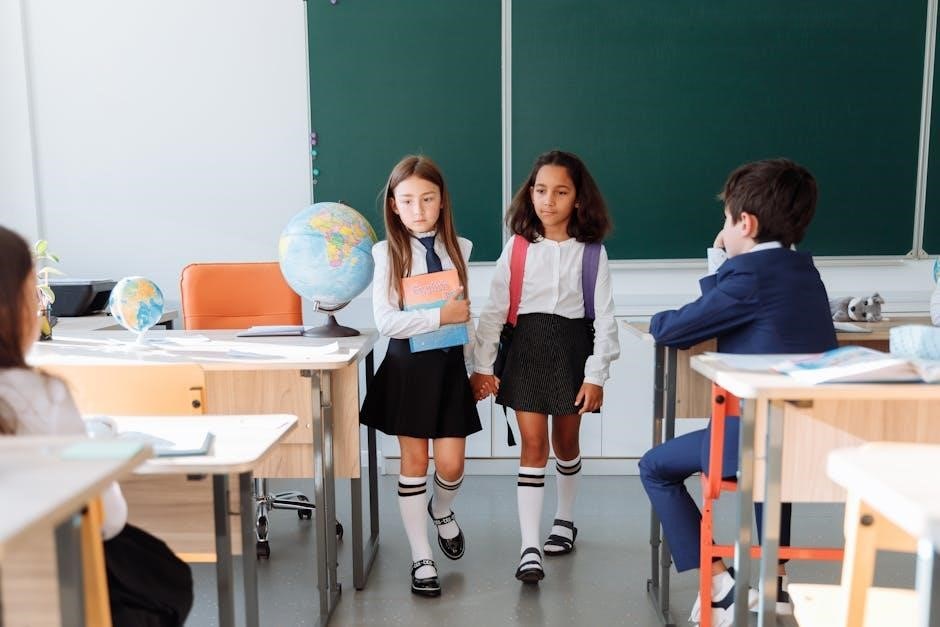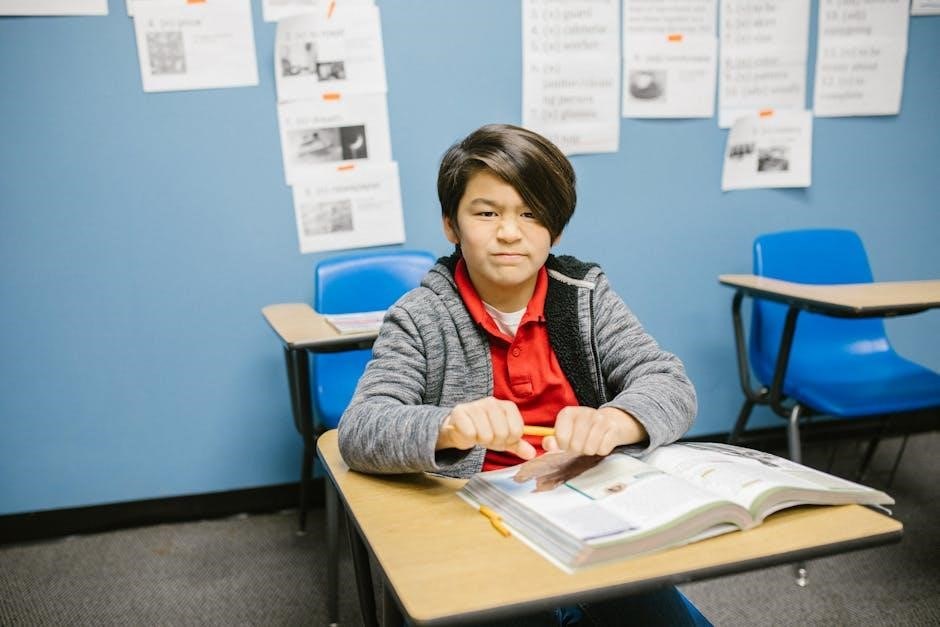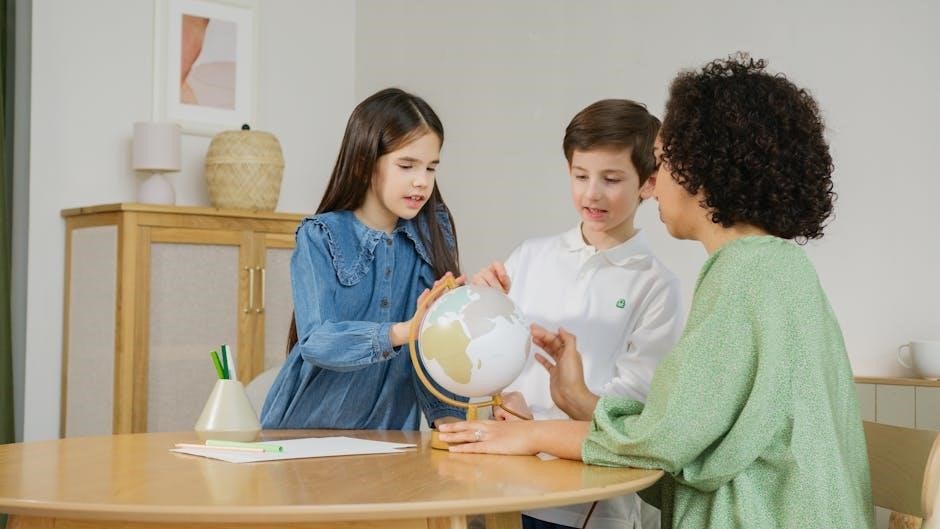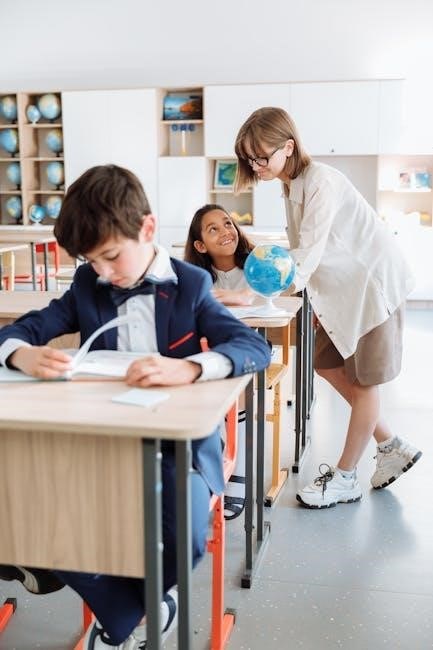The Boy at the Back of the Class: A Comprehensive Overview
Seeking a “The Boy at the Back of the Class” PDF? Numerous online resources offer access, but caution is advised regarding unofficial downloads.
Educational platforms and legitimate retailers provide secure options for obtaining this impactful story, published May 15, 2025.
Understanding the Core Narrative
The story centers around Ahmet, a nine-year-old Syrian refugee who arrives mid-year at a British primary school, filling an empty chair at the back of Mrs. Khan’s classroom. Initially, Ahmet remains withdrawn and silent, sparking curiosity and a degree of apprehension amongst his classmates. The narrative unfolds primarily through the eyes of Aisha, a perceptive student who becomes determined to understand Ahmet’s story and help him integrate.
The core of the narrative isn’t simply about a new student; it’s about dismantling preconceived notions and fostering empathy. Aisha and her classmates embark on a “class project” – a series of questions designed to learn about Ahmet’s life before arriving in the UK. This process gradually reveals the hardships he’s faced, the family he left behind, and the reasons for his initial reticence.
The book, published on May 15, 2025, skillfully portrays the emotional landscape of displacement and the challenges of adapting to a new culture. While seeking a “The Boy at the Back of the Class” PDF is understandable for accessibility, experiencing the full narrative through the published book enhances the emotional impact and understanding of the story’s powerful message.
The Story’s Central Theme: Empathy and Acceptance
At its heart, “The Boy at the Back of the Class” champions empathy and acceptance as vital tools for bridging cultural divides and overcoming prejudice. The narrative demonstrates how simple acts of kindness and genuine curiosity can dismantle barriers and foster understanding between individuals from vastly different backgrounds.
The story powerfully illustrates the importance of looking beyond initial impressions and actively seeking to understand another person’s experiences. Through Aisha’s journey, readers witness the transformative power of asking questions and listening with an open heart. The initial hesitation and curiosity of the class gradually evolve into compassion and a desire to help Ahmet feel welcome.
While access to a “The Boy at the Back of the Class” PDF might seem convenient, the book’s true impact lies in its ability to evoke emotional resonance and inspire readers to practice empathy in their own lives. Published May 15, 2025, it’s a poignant reminder that acceptance begins with understanding, and understanding begins with a willingness to connect.

Introducing Ahmet: The Syrian Refugee Protagonist
Ahmet, the nine-year-old Syrian refugee, is the quiet center of this compelling story. He arrives at Mrs. Khan’s classroom filling the previously empty chair, immediately sparking the curiosity of his classmates. Initially, Ahmet is presented as reserved and withdrawn – he doesn’t smile much and rarely speaks, a direct consequence of the trauma he’s experienced.
His silence isn’t indifference, but rather a protective shield built around a heart burdened by displacement and loss. The narrative subtly reveals the challenges Ahmet faces as he navigates a new culture, a new language, and a new school environment. He embodies the vulnerability and resilience of countless refugee children worldwide.
Finding a “The Boy at the Back of the Class” PDF allows access to Ahmet’s story, but the book’s power resides in its ability to humanize the refugee experience. Published May 15, 2025, it invites readers to step into Ahmet’s shoes and understand the world from his perspective, fostering empathy and challenging preconceived notions.
Mrs. Khan’s Role: Fostering Understanding
Mrs. Khan embodies the ideal educator, skillfully guiding her class towards empathy and acceptance. Recognizing Ahmet’s initial isolation, she doesn’t force integration but subtly encourages curiosity and understanding. Her approach is one of gentle facilitation, prompting her students to ask questions and learn about Ahmet’s background and experiences.
She cleverly utilizes a “class project” – a detailed investigation into each student’s journey to the school – as a catalyst for connection. This inclusive activity allows Ahmet to share his story at his own pace, fostering a safe space for vulnerability and open communication. Mrs. Khan’s wisdom lies in her ability to transform curiosity into compassion.
Accessing a “The Boy at the Back of the Class” PDF reveals the profound impact of her teaching methods. Published May 15, 2025, the book highlights how educators can play a vital role in bridging cultural divides and creating inclusive learning environments for all students, especially those facing unique challenges.
The Initial Class Reaction: Curiosity and Hesitation
The arrival of Ahmet, a Syrian refugee, immediately sparks a mixture of curiosity and hesitation amongst Mrs. Khan’s students. Initially, the children observe him from a distance, noting his quiet demeanor and lack of a smile. This initial reaction isn’t born of malice, but rather from unfamiliarity and a natural human tendency to be cautious of the unknown.
They wonder about his story, his life before arriving, and the reasons behind his reserved nature. This curiosity is tempered by a degree of uncertainty; they don’t know how to approach him or what to say. The empty chair at the back of the class, now occupied, becomes a focal point of their collective attention.
Exploring a “The Boy at the Back of the Class” PDF (published May 15, 2025) reveals how this initial reaction is a crucial element of the narrative. It demonstrates the power of overcoming preconceived notions and the importance of extending kindness to those who are different.

Exploring the Context of the Story
Understanding the broader context enhances the reading experience. A “The Boy at the Back of the Class” PDF (published May 15, 2025) gains depth when considering the Syrian refugee crisis and its impact.
The Syrian Refugee Crisis: A Background
The narrative within “The Boy at the Back of the Class,” and readily accessible via a PDF version (published May 15, 2025), is deeply rooted in the ongoing Syrian Refugee Crisis. This complex humanitarian issue began escalating in 2011 with the outbreak of the Syrian Civil War, forcing millions to flee their homes in search of safety and stability.
The conflict, characterized by widespread violence and political instability, created an unprecedented displacement crisis. Families were uprooted, communities were shattered, and a generation of children faced unimaginable hardship. Neighboring countries like Lebanon, Jordan, and Turkey initially absorbed the majority of refugees, but the sheer scale of the crisis eventually led to significant migration towards Europe and beyond.
Understanding this backdrop is crucial when engaging with Ahmet’s story. The book sensitively portrays the challenges faced by Syrian refugees, highlighting the trauma of displacement, the difficulties of adapting to a new culture, and the longing for home. Accessing a “The Boy at the Back of the Class” PDF allows readers to delve into this important topic and foster empathy for those affected by the crisis. The story, published on May 15, 2025, serves as a powerful reminder of the human cost of conflict.
Impact of Displacement on Children
“The Boy at the Back of the Class,” available as a PDF since May 15, 2025, powerfully illustrates the profound impact of displacement on children like Ahmet. Beyond the immediate physical dangers of conflict, displacement inflicts deep emotional and psychological scars. Children often experience trauma, loss, and separation from family members, leading to anxiety, depression, and post-traumatic stress.
The disruption of education is another significant consequence. Refugee children frequently face barriers to accessing schooling, hindering their development and future opportunities. Adapting to a new language, culture, and educational system presents immense challenges. Feelings of isolation, discrimination, and a loss of identity are also common.
The book sensitively portrays Ahmet’s initial silence and withdrawal as a manifestation of these struggles. A PDF copy allows readers to explore these themes with greater depth. It emphasizes the importance of creating welcoming and supportive environments for refugee children, fostering a sense of belonging, and providing access to mental health services. Understanding these impacts is vital for promoting healing and integration, as highlighted in the story published May 15, 2025.

The Challenges of Integration for Refugee Children
“The Boy at the Back of the Class,” readily available as a PDF since May 15, 2025, vividly depicts the complex challenges refugee children face when integrating into new communities. Language barriers are often the most immediate hurdle, hindering communication and academic progress; Cultural differences can lead to misunderstandings and social isolation, making it difficult to form friendships and navigate daily life.
Beyond language and culture, refugee children may grapple with feelings of loss, grief, and uncertainty about their future. The trauma of displacement can manifest in behavioral issues or emotional distress, requiring specialized support. Navigating unfamiliar systems – education, healthcare, and social services – can be overwhelming for both children and their families.

The story, accessible through a PDF version, underscores the importance of empathy, patience, and proactive support from schools and communities. Creating inclusive environments, providing language assistance, and fostering cultural understanding are crucial steps. The book, published May 15, 2025, highlights how small acts of kindness and genuine connection can make a significant difference in a child’s integration journey.
Cultural Differences and Misunderstandings
“The Boy at the Back of the Class,” available as a PDF since May 15, 2025, powerfully illustrates how cultural differences can breed misunderstandings and initial hesitation. Ahmet, a Syrian refugee, initially appears withdrawn and doesn’t smile readily, leading his classmates to speculate and misinterpret his behavior. These initial reactions stem from unfamiliarity with Syrian customs and communication styles.
The narrative, accessible through the PDF, demonstrates how assumptions based on cultural norms can create barriers to connection. The children’s curiosity, while natural, is initially fueled by a lack of understanding. Mrs. Khan skillfully guides them to move beyond superficial observations and actively seek to learn about Ahmet’s background and experiences;
The book, published May 15, 2025, emphasizes the importance of recognizing that silence or reservedness doesn’t equate to unhappiness or disinterest. It highlights the need for open communication, respectful questioning, and a willingness to embrace diversity. The PDF version serves as a valuable tool for fostering cross-cultural understanding and empathy in young readers.

Analyzing Key Elements of the Book
The “Boy at the Back of the Class” PDF, released May 15, 2025, utilizes a class project to spark empathy. Aisha’s narration and the symbolic empty chair powerfully drive home the story’s core message.
The “Class Project” as a Catalyst for Change
The ingenious “class project” within “The Boy at the Back of the Class” PDF (published May 15, 2025) serves as the pivotal turning point, transforming initial curiosity and hesitation into genuine understanding and acceptance of Ahmet. Mrs. Khan cleverly orchestrates a collective effort where each student dedicates themselves to learning about Ahmet’s life before arriving in the UK.
This isn’t merely a research assignment; it’s a deeply empathetic undertaking. The children meticulously gather information, asking thoughtful questions – a process beautifully highlighted within the narrative available in the PDF version. The project dismantles preconceived notions and replaces them with a nuanced appreciation for Ahmet’s experiences as a Syrian refugee.
The collaborative nature of the project is crucial. It fosters a sense of shared responsibility and encourages the students to move beyond individual perspectives. As they piece together Ahmet’s story, they begin to recognize his humanity and the challenges he’s overcome. The PDF showcases how this shared journey builds bridges and ultimately creates a more inclusive classroom environment, demonstrating the power of collective empathy.
Aisha’s Perspective: The Narrator’s Journey
Aisha, the narrator in “The Boy at the Back of the Class” PDF (released May 15, 2025), provides a uniquely intimate and evolving perspective on Ahmet’s integration. Initially, like her classmates, she’s filled with curiosity and a degree of apprehension towards the silent Syrian refugee. The story, readily accessible in the PDF format, unfolds entirely through her eyes, allowing readers to experience her internal shifts firsthand.
Her journey isn’t one of instant understanding, but rather a gradual process of learning and empathy. Aisha’s initial questions, often mirroring those of her peers, become more thoughtful and compassionate as the “class project” progresses. The PDF beautifully illustrates her growing awareness of the complexities of Ahmet’s situation and the trauma he’s endured.
Through Aisha’s narration, the author skillfully demonstrates how preconceived notions can be challenged and overcome. Her transformation serves as a powerful example of the impact of empathy and the importance of actively seeking to understand others, making the PDF a compelling read for young audiences.
The Power of Questions: Uncovering Ahmet’s Story
Within the pages of “The Boy at the Back of the Class” PDF (published May 15, 2025), questions emerge as a pivotal tool for bridging cultural divides and fostering understanding. The class’s initial curiosity about Ahmet, the Syrian refugee, transforms into a structured “project” centered around asking him questions – carefully considered and respectfully posed.
This approach, vividly depicted in the PDF, highlights the power of genuine inquiry over assumptions. Each question, though seemingly simple, peels back layers of Ahmet’s story, revealing his life before displacement, his journey to a new country, and the challenges he faces adapting to a new school and culture. The PDF demonstrates how asking “why” can unlock empathy.
The narrative skillfully illustrates that asking questions isn’t about satisfying curiosity, but about demonstrating respect and a willingness to learn. It’s a powerful lesson for young readers, showcasing how open communication can dismantle prejudice and build connections, making the PDF a valuable resource.
Symbolism of the Empty Chair

Examining “The Boy at the Back of the Class” PDF (released May 15, 2025), the initially empty chair at the rear of Mrs. Khan’s classroom functions as a potent symbol of absence and unspoken stories. Before Ahmet’s arrival, it represents the void left by those displaced, a silent acknowledgment of the Syrian refugee crisis and the children impacted by it.
The chair’s emptiness embodies loneliness and the feeling of being unseen. However, with Ahmet filling the space, the symbolism shifts dramatically. It transforms into a representation of hope, inclusion, and the potential for connection. The PDF powerfully illustrates how a simple object can embody complex emotions and societal issues.
Throughout the narrative, accessible within the PDF, the chair serves as a constant reminder of Ahmet’s journey and the importance of welcoming newcomers. It’s a visual metaphor for opening hearts and minds, ultimately advocating for empathy and acceptance – central themes of the book.

Resources and Availability of “The Boy at the Back of the Class” PDF
Finding the “The Boy at the Back of the Class” PDF requires careful navigation. Legitimate educational platforms and book retailers offer secure access to this May 15, 2025, release.
Legitimate Sources for PDF Downloads
Accessing a digital copy of “The Boy at the Back of the Class” through authorized channels ensures both quality and supports the author and publisher. Several reputable platforms offer the PDF version for purchase or through educational subscriptions. Epic!, a popular digital reading platform for children, frequently includes this title in its library, accessible with a subscription. Similarly, Raz-Kids, another educational resource, may provide access for students and educators.
Book retailers like Amazon and Barnes & Noble often offer the eBook version, which can be downloaded as a PDF. Checking directly with the publisher, Barrington Stoke, is also a reliable method. They may offer the PDF directly on their website or provide links to authorized distributors. Educational institutions frequently have site licenses for digital books, making the PDF available to students and teachers through school or library portals.
Always verify the source before downloading to avoid potential security risks and ensure you are obtaining a legitimate copy of this impactful story, published May 15, 2025. Purchasing from trusted sources guarantees a high-quality reading experience and supports the creation of similar valuable literature.
Potential Risks of Unofficial PDF Downloads
Downloading “The Boy at the Back of the Class” PDF from unofficial sources carries significant risks. These websites often host malware, viruses, and other malicious software disguised as legitimate files, potentially compromising your device and personal information. The quality of these illegally distributed PDFs is frequently poor, featuring formatting errors, missing pages, or unreadable text, diminishing the reading experience.
Furthermore, accessing copyrighted material through unauthorized channels is illegal and unethical, undermining the author’s rights and the publishing industry. Such sites often lack proper security protocols, increasing the risk of identity theft and financial fraud. Downloading from untrusted sources can expose you to phishing scams and unwanted advertisements.

Prioritize safety and legality by opting for legitimate sources, even if it requires a purchase. Supporting authorized platforms ensures a secure download, a high-quality reading experience, and respects the intellectual property rights of the author, whose impactful story was published May 15, 2025. Protect your digital wellbeing and choose wisely when seeking a digital copy.
Availability on Educational Platforms
Numerous educational platforms offer access to “The Boy at the Back of the Class,” often catering specifically to classroom use and reading programs. These platforms frequently provide the book in digital formats, including PDFs, alongside supplementary teaching resources like lesson plans, discussion guides, and comprehension quizzes. Popular options include Epic!, Raz-Kids, and various school district-subscribed digital libraries.
These platforms prioritize secure access and often adhere to copyright regulations, ensuring a legal and safe reading experience. Many offer features like adjustable font sizes, text-to-speech functionality, and annotation tools, enhancing accessibility and engagement for students. Teachers can easily assign the book to their classes and monitor student progress.
While a free PDF download might seem appealing, educational platforms provide a curated and supported environment for learning. The book, published May 15, 2025, is readily available through these channels, offering a reliable and enriching experience for both educators and students. Check with your school or local library for access details.
Cost and Purchasing Options (Beyond PDF)
Beyond seeking a PDF version, “The Boy at the Back of the Class” is widely available in physical formats, offering a tangible reading experience. The paperback edition typically ranges from $9.99 to $12.99, depending on the retailer and any ongoing promotions. Hardcover editions are available for around $17.99 to $22.99, providing a more durable option for frequent use.
Audiobook versions are also accessible through platforms like Audible, offering a convenient way to experience the story. Audiobook prices generally fall between $15.00 and $20.00, or can be included as part of an Audible subscription. E-book versions, available on Kindle and other e-reader platforms, are often priced similarly to the paperback.

Purchasing directly from the publisher or major booksellers like Amazon and Barnes & Noble ensures authenticity and supports the author. Considering the book’s publication date of May 15, 2025, newer editions may be available. Exploring these options provides a quality reading experience beyond simply searching for a free PDF.
